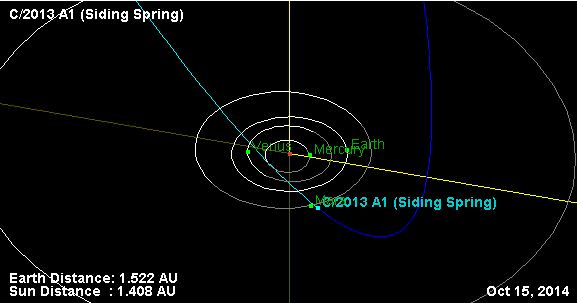There is a small but non-negligible chance that Comet 2013 A1 will hit Mars October of 2014. According the latest calculations from JPL, the comet is estimated to come within 120,000 kilometers (74,000 miles). In this video, various NASA scientists discuss the potential impact, and invariably view such an impact as scientifically very intriguing.
“I think of it as a giant climate experiment,” said Michael Meyer, lead scientist for the Mars Exploration Program. “An impact would loft a lot of stuff into the Martian atmosphere–dust, sand, water and other debris. The result could be a warmer, wetter Mars than we’re accustomed to today.”
An impact would likely have consequences for the current rovers on Mars. Meyer said the solar-powered Opportunity might have a hard time surviving if the atmosphere became opaque. Nuclear-powered Curiosity, though, would carry on just fine. He also notes that Mars orbiters might have trouble seeing the surface, for a while at least, until the debris begins to clear.
The trajectory for comet Siding Spring is being refined as more observations are made. Rob McNaught discovered this comet on Jan. 3, 2013, at Siding Spring Observatory in Australia, and looking back at archival observations has unearthed more images of the comet, extending the observation interval back to Oct. 4, 2012. Further refinement to its orbit is expected as more observational data is obtained.
Scientists estimate the nucleus of the comet is about 1 to 3 km in diameter. If it gets close to Mars and is grabbed by its gravity,and IF there was an impact it would be a substantial hit. “If it does hit Mars, it would deliver as much energy as 35 million megatons of TNT,” said Don Yeomans of NASA’s Near-Earth Object Program at JPL. According to what Yeomans says in this video, the current odds of it hitting Mars is about 1 in 2,000, but according to the parameters at JPL’s website, it appears the odds are about 1 in 10,000.
Source: Science@NASA

